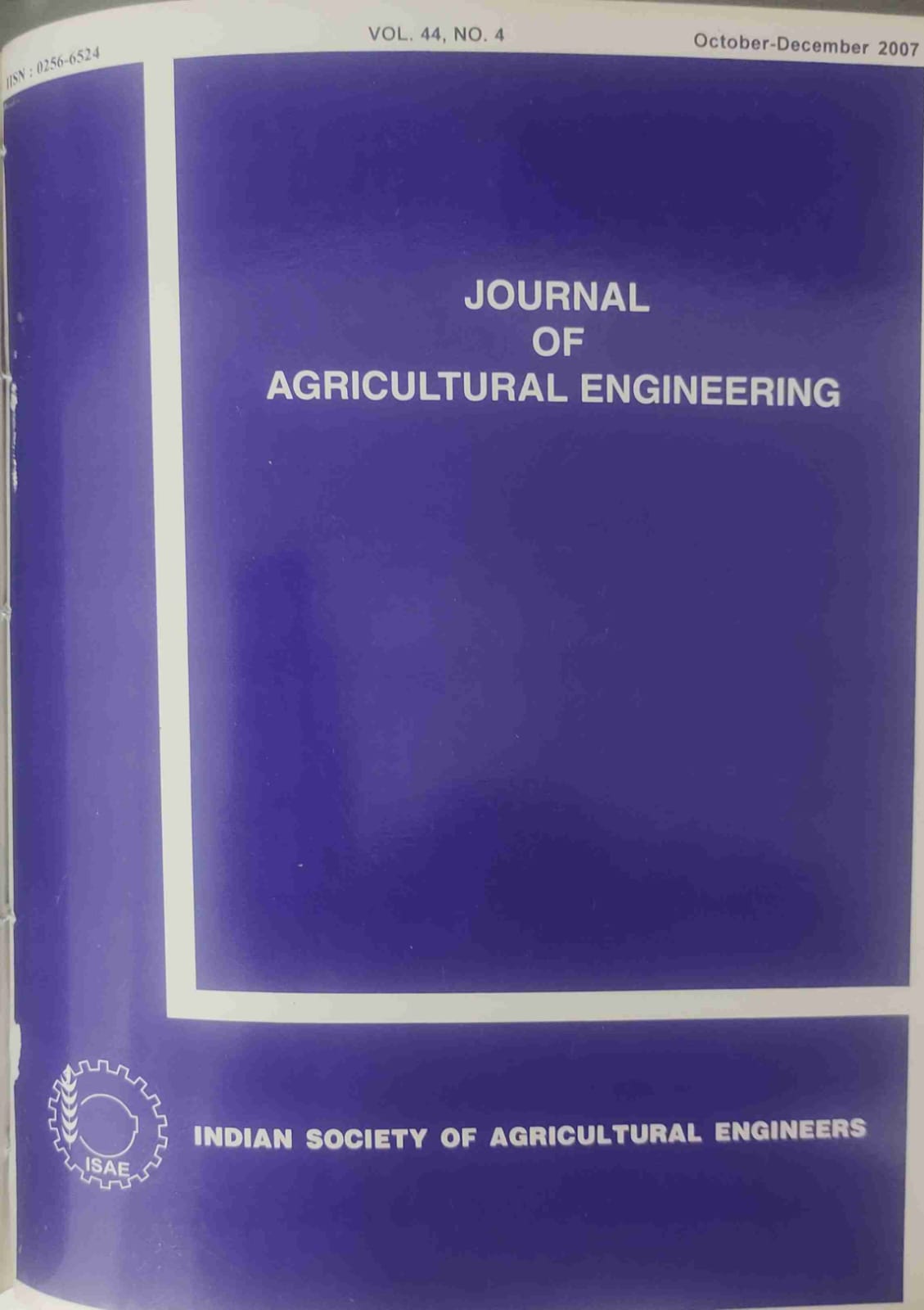Development of a Geomorphology based Model for Prediction of Surface Run off from Ungauged Watersheds
DOI:
https://doi.org/10.52151/jae2007444.1295Abstract
Presence of a plethora of ungauged and inadequately gauged watersheds in India necessitates development of models for these watersheds to predict the hydrologic responses with acceptable accuracy. Besides the Curve Number (CN) approach, the geomorphologic instantaneous unit hydrograph (GIUH) models are adopted by the researchers for estimation of surface runoff from ungauged watersheds. This paper discusses the adequacy of a modified exponential distributed geomorphologic instantaneous unit hydrograph (ED-GIUH) model in generating direct run off hydrographs (DRHs). The ED-GIUH concept was used to generate the DRHs for the Banha watersheds under Upper Damoder Valley, Jharkhand, India. The estimated runoff using the ED-GIUH concept was compared with the original Natural Resources Conservation Service Curve Number (NRCS CN) generated runoff and validated with the observed runoff data of the watershed. The accuracy of estimation of these approaches were compared to ascertain the applicability of ED-GIUH and CN concepts for runoff prediction from ungauged watershed in India. The model input data, including natural drainage network and Horton's morphological parameters were prepared using a watershed morphological estimation tool (WMET) interface of ArcGIS@. The path probability of channel and overland flow were estimated from the generated feature classes of watershed topology and drainage networks to derive the instantaneous unit hydrograph (IUH). Further, from the IUH, an accounting procedure was used to estimate unit hydrograph (UH) and DRHs for different rainfall events occurring over the watershed. It was observed that the ED-GIUH technique were better (coefficient of determination (R2) =0.97, model efficiency (E) =0.96) than the NRCS- CN approach (R2 =0.74, E = 0.71) when compared with the observed DRH resulting from rainfall events of6h duration or less. However, for rainfall events greater than 6h, the ED-GIUH method (R2= 0.71, E = 0.58) failed to predict the surface runoff accurately than the CN method (R2 = 0.89, E = 0.84). Thus, facilitated by using Arc GISoo, the ED-GIUH model could be used to predict DRHs from small duration events more accurately than the CN approaches for ungauged watersheds having similar geomorphology as that of the Banha watershed.
References
Chow V T; Maidment D R; Mays L W. 1988. Applied Hydrology. McGraw-Hill Company, NY.
Clark C o. 1945. Storage and the unit hydrograph, Trans.ASCE, 110, 1419-1446.
Franchini M; O'Connell P E. 1996. An analysis of the dynamic component ofthe geomorphologic instantaneous unit hydrograph. J. Hydrology, 175, 407-428.
Gupta V K; Wymire E D; Wang C T. 1980. A Representation of an Instantaneous Unit Hydrograph from Geomorphology, Water Resources Res., 16(5), 855-862.
HEC. 2000. Hydrologic Engineering Centre HEC-HMS User's Manual, Davis, California.
Horton R. 1945. Erosional development of streams and their drainage basin: hydrophysical approach to quantitative morphology. Geological Society of America Bulletin, 56,275-370.
Jain S K; Singh R D; Seth S M. 2000. Design flood estimation using GIS supported GIUH approach. Water Resources Mgt., 14, 369-376.
Jain V; Sinha R. 2003a. Derivation of in it hydrograph from GIUH analysis for a Himalayan river. Water Resources Mgt., 17, 355-375.
Jain V; Sinha R. 2003b. Evaluation of geomorphic control on flood hazard through Geomorphic Instantaneous Unit Hydrograph. Current ScL, 85(11), 1596-1600.
McCuen R.1997. Hydrologic Analysis and Design. Second Ed., Prentice-Hall, NJ.
Mishra S K; Jain M K; Bhunya P K; Singh V P. 2005. Field Applicability of the SCS-CN-Based Mishra-Singh General Model and its Variants. Water Resources Mgt., 19, 37-62.
Mishra S K; Singh V P; Sansaleve J J. 2003. A modified SCS-CN Method: Characterization and Testing. Water Resources Mgt., 17, 37-68.
Ritter D F; Kochel R C; Miller J R. 2002 Process Geomorphology, Mc Graw Hill, Boston.
Rodriguez-Iturbe I; Rinaldo A. 1997. Fractal River Basins. Cambridge University Press, UK.
Rodriguez-Iturbe I; Valdes J. 1979. The geomorphological structure of hydrologic response. Water Resources Research, 15 (6), 1409-1420.
Rodriguez-lturbe I; Gonzalez-Sanabria M; Bras R. 1982. A geomorphoclimatic theory of the instantaneous unit hydrograph. 'Water Resources Res., 18 (4), 877-886.
Sarangi A; Bhattacharya A K. 2005. Comparison of Artificial Neural Network and regression models for sediment loss prediction from Banha watershed in India. Agric. Water Mgt., 78,195-208.
Sarangi A; Madramootoo C A; Singh D K. 2004. Development of ArcGIS assisted user interfaces for estimation of watershed morphologic parameters. J. Soil Water Cons., 3(3&4), 139-149.
Sarangi A; Madramootoo C A; Enright P; Prasher S 0; Patel R M. 2005. Performance evaluation of ANN and geomorphology-based models for runoff and sediment yield prediction for a Canadian watershed. Current Sci., 89(12), 2022-2033.
Singh V P. 1988. Hydrologic Systems: Rainfall-Runoff Modeling. vol. .1 Englewood Cliffs, Prentice Hall, N.J. Smart J. 1972. Channel networks. Advances in Hydroscience, 8, 305-346.
Sarman A U. 1995. Estimation of peak discharge using GIUH model in Saudi Arabia. J. Water Resources Planning and Mgt., 121(4),287-293.
Strahler AN. 1957. Quantitative Analysis of Watershed Geomorphology. Trans. American Geophysicsical Union, 38(6), 913-920.
Wang C; Gupta V; Waymire E A. 1981. Geomorphologic synthesis of non-linearity in surface runoff. Water Resources Res., 17, 545-554.
Zhang B; Govindaraju R. 2003.Geomorphology-based artificial neural networks (GANNs) for estimation of direct runoff over watershed~. J. Hydrology, 273,18-34.














